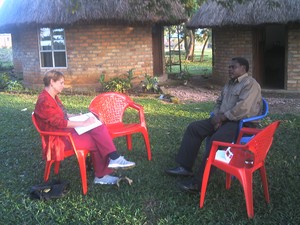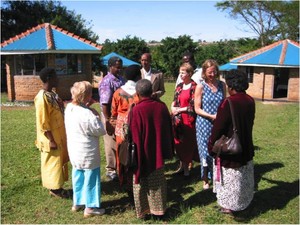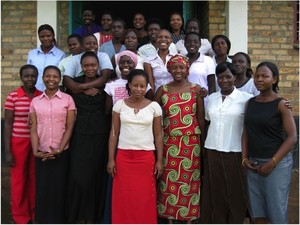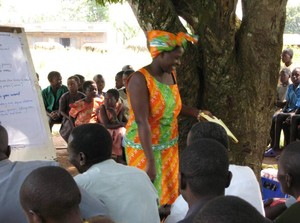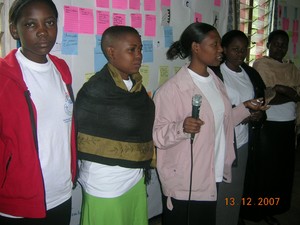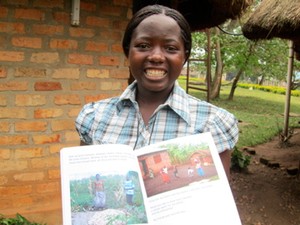Patty Seybold Honored on International Women’s Day in Uganda
On March 8, 2015, International Women’s Day, Patty Seybold was recognized as a “woman of distinction” for the work she has done since 2006 in support of the African Rural University for Women and of the Uganda Rural Development and Training programme. The award ceremony kicked off a week of festivities on the University campus in honor of International Women’s Day.
Patty Seybold interviewing Mwalimu Musheshe, the founder of URDT and the African Rural University.
Patty Seybold has served on the African Rural University Council (its Board) since its founding in 2006, and usually visits the 80-acre campus and organic demonstration farm in Kagadi, in the Kibaale District in western Uganda, twice a year for board meetings and to spend time with students, faculty, and with members of the communities where the University’s interns and graduates work as rural transformation specialists.
Patty Seybold with other members of the African Rural University Council.
“What’s unique about this University,” Patty explained, “is that it’s the first all-women’s university in Uganda, and it provides a Bachelors’ of Science degree in Rural Transformation. The goal is not to send these young women to the big city to jobs in business, but to equip them to be effective change agents in the rural countryside. The University curriculum was co-developed by the University founders, the students, the faculty, and the members of the surrounding communities. After four years of study and two years of internships, ARU graduates have been employed in 17 sub-counties—each graduate overseeing 30 to 50 villages—to work with community members to help them identify and carry out the projects that will increase incomes, nutrition, sanitation, health, agricultural production, and business development. Based on the learnings and results the people in these villages have experienced, the University curriculum has been continuously evolved.”
The first class of students who joined the African Rural University in 2006.
“These young women are truly inspirational. I’ve learned so much from being part of this innovative educational experience,” she said. Patty has traveled to the URDT and ARU campus a dozen times in the last decade. Each time she visits the campus, Patty undertakes a research project—hoping to learn and to understand more about all the ways in which the community members, students, faculty, and staff of URDT, ARU, and its sister institutions are innovating. She documents her research in articles we publish in our Customers.com Strategies research service.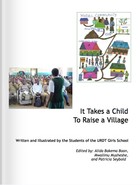
As a published author, Patty offered to help the students at the URDT Girls School (ages 10 through 18) write and publish their own book. In 2010, with the help and support of the leadership and staff of the URDT Girls School, Patty and the faculty selected essays and drawings from forty students about their “back home” projects and turned these into a published book: It Takes a Child to Raise a Village.
Back Home projects are projects that each girl’s family initiates with the student’s support and guidance. The family members create a vision of how they’d like to improve their household, their farm, or their village, and they carry out the project in a semester while the student is back at the school. The students are graded on the results of their families’ projects. Many of these Back Home projects result in increased income and improved sanitation and nutrition. By the time their daughters graduate from high school, the girls’ families have pulled themselves out of poverty and become prosperous role models in their communities.
Resty Namubiru, when she was an African Rural University student, working with villagers to elicit their visions and current reality.
On several of her visits, Patty has taught classes in our customer co-design methodology known as Customer Scenario® Mapping, which enables customers to articulate a shared vision of the experience and results they would like to have, to develop a set of prioritized actions they can take to achieve their vision, and to create a customer scorecard they can use to judge their results. Patty has taught these customer co-design techniques to ARU faculty, ARU students, and Girls School faculty.
A team of ARU students demonstrating their ability to lead Customer Scenario Mapping workshops in 2007.
Safira shows off the book she co-authored. It's the first book her family owned!
After almost a decade of studying the URDT and ARU model, Patty coined the term “customer ecosystem” to describe organizations that are designed in ways that emulate URDT. A customer ecosystem is a group of organizations that are all aligned around a common goal: to help customers achieve the results they want; in other words, their visions. She’s currently working on her next book (about customer ecosystems), in which she hopes to include a case study about the creation of the African Rural University and the work of many of its graduates as Epicenter Managers in rural communities.
Patty feels privileged to be working with the students, faculty, staff, and Council members of ARU. She’s delighted to have the opportunity to chronicle the great work and the innovative approaches that URDT’s organizations design, pilot, and evolve in partnership with the community members they serve and whose visions they support.
0 comments
Be the first one to comment.


